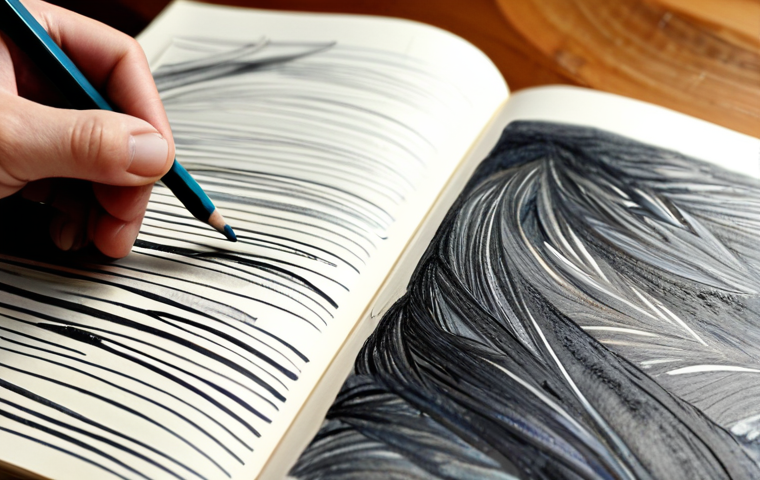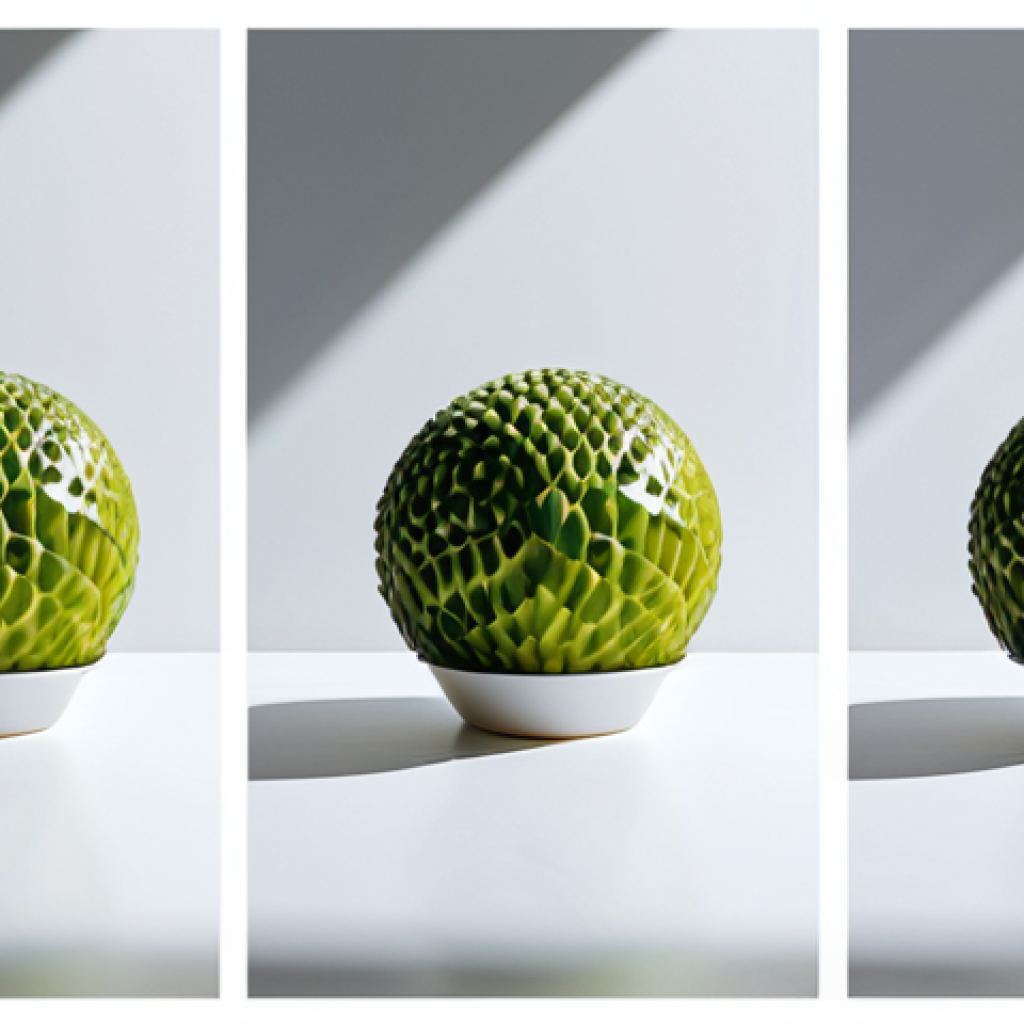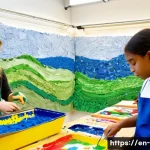Hey creative souls and aspiring artists! Are you dreaming of taking your passion for art to the next level, perhaps at a top-tier art school or university program?
Trust me, I’ve been there, navigating the labyrinthine process of high school art admissions, and I know firsthand it can feel a little daunting. It’s not just about drawing pretty pictures anymore; today’s art schools are looking for so much more – your unique voice, your thought process, and that spark of individuality that makes *your* work truly stand out from the crowd.
The landscape of art school applications has evolved significantly, with digital portfolios taking center stage and a huge emphasis on showcasing not just technical skill, but also your conceptual thinking and willingness to experiment.
From what I’ve observed and learned from countless success stories, the secret often lies in crafting a portfolio that tells *your* story, complete with those messy sketchbook pages that reveal your creative journey and the personal statement that articulates your deepest inspirations.
It’s about demonstrating your dedication, your unique perspective, and how you engage with the world creatively. Forget generic essays – admissions committees want to see *you*.
So, if you’re feeling a mix of excitement and overwhelm, wondering how to make your application shine in this competitive environment, you’re in the right place.
We’re going to dive deep into exactly what today’s admissions teams are looking for and how you can prepare an application that truly reflects your artistic potential.
Let’s get into the nitty-gritty and uncover the strategies that actually work!
Crafting a Portfolio That Screams “You!”

Beyond Pretty Pictures: Your Unique Visual Voice
Okay, let’s get real about portfolios. When I was applying, I thought it was all about showing off my most “perfect” pieces, meticulously rendered still lifes and technically brilliant figure drawings.
And sure, technical skill is absolutely foundational – you’ve got to show you know your stuff! But what I quickly learned, and what truly sets successful applicants apart today, is demonstrating your unique visual voice.
Admissions officers aren’t just looking for someone who can copy reality; they want to see how *you* interpret it, how *your* personality filters through your brushstrokes, your digital manipulations, or your sculptural forms.
Think about those pieces that feel most authentically *you*. Maybe it’s a series exploring a niche interest, or a mixed-media piece that combines traditional painting with found objects, reflecting your view on consumerism.
I remember one student I mentored, Sarah, who got into her dream school primarily because her portfolio featured a series of surrealist self-portraits made with discarded fashion magazines.
It wasn’t just technically sound; it was conceptually rich and undeniably *her*. Don’t shy away from showing your quirks or your distinct way of seeing the world – that’s your superpower!
Showcasing Diverse Mediums and Techniques
It’s easy to stick to what you know best, right? If you’re a whiz with charcoal, you might be tempted to fill your portfolio with charcoal drawings. But here’s a tip from someone who’s been through it: art schools genuinely love to see versatility.
It tells them you’re curious, adaptable, and willing to experiment – all crucial traits for a thriving artist. When I was putting together my own portfolio, I made a conscious effort to include pieces in at least three different mediums: painting, sculpture, and digital art.
It wasn’t about being a master of all of them, but about showing that I wasn’t afraid to step outside my comfort zone and explore new ways of expressing myself.
Think about it: a piece that demonstrates your command of traditional oil painting alongside a vibrant digital illustration or even a short animation can make a much stronger impression than a dozen similar works.
It indicates a broad artistic understanding and a potential for growth that admissions committees find incredibly appealing. So, take a moment to assess your collection.
Does it show you can move fluidly between drawing and painting, sculpture and printmaking, or even photography and graphic design? A diverse portfolio hints at a well-rounded artistic mind, eager to learn and expand.
Beyond the Masterpiece: Showcasing Your Process
The Power of the Sketchbook: Your Creative Journal
Forget about just polished, finished pieces. Admissions committees are deeply interested in your creative journey, and there’s no better window into that than your sketchbooks.
Seriously, these aren’t just for doodling; they are a goldmine of your raw ideas, experiments, mistakes, and problem-solving. When I was applying, my art teacher emphasized including some of my most “messy” but insightful sketchbook pages.
At first, I was hesitant – who wants to show their half-baked ideas? But she was absolutely right. These pages reveal your thought process, how you develop concepts, and how you learn from trials and errors.
They demonstrate a genuine engagement with your craft, not just an ability to produce a pretty final product. Think of your sketchbook as a visual diary of your artistic growth, filled with observational drawings, brainstorming sessions, color studies, conceptual notes, and even failed experiments.
It shows that you’re a thinker, a curious explorer, and someone who’s constantly engaging with their artistic practice, even when no one is watching. Showing those imperfect yet honest pages truly humanizes your application and adds incredible depth.
From Idea to Execution: Storytelling Through Your Work
One of the biggest mistakes aspiring artists make is presenting their work as isolated, disconnected pieces. What truly resonates with admissions teams is seeing a narrative thread, understanding how an idea evolves from its initial spark to a complete work.
This is where process truly shines. Imagine presenting a series of works that document the evolution of a single concept, perhaps starting with initial sketches, moving through material tests, failed attempts, and culminating in the final piece.
This approach, often called “process documentation,” is incredibly powerful. It demonstrates not just your technical abilities but your conceptual rigor, your problem-solving skills, and your persistence.
For example, if you created a large sculpture, include photos of its construction at various stages, perhaps with notes on the challenges you faced and how you overcame them.
It’s like inviting the committee into your studio, letting them witness your dedication and the intellectual heavy lifting behind your art. This kind of storytelling about your artistic journey makes your portfolio not just a collection of images, but a compelling argument for your potential as a serious art student.
It’s about showing *how* you think and *how* you create, which is often more valuable than just showing *what* you’ve created.
The Personal Statement: Your Artistic Soul on Paper
Finding Your Authentic Voice and Vision
Ah, the personal statement – this is where you get to truly speak directly to the admissions committee, unhindered by the visual limitations of a portfolio.
But here’s the thing: it’s not just another essay. This is your chance to articulate your deepest inspirations, your artistic philosophy, and why *you* are driven to create.
I remember staring at a blank screen for hours, trying to sound “smart” and “artistic,” only to realize I was writing what I thought they *wanted* to hear, not what I actually felt.
The breakthrough came when I stopped trying to impress and started speaking from the heart. What experiences have shaped your artistic perspective? What themes continually draw you in?
What makes you passionate about art? For me, it was my fascination with urban decay and how forgotten spaces hold so much history and untold stories. Sharing that personal connection, those genuine observations and emotions, is what makes your statement sing.
It’s about being vulnerable, authentic, and allowing your unique personality to shine through. Admissions officers read thousands of these; trust me, they can spot a generic, ChatGPT-esque essay a mile away.
Beyond the “Love of Art”: Specificity and Future Aspirations
While expressing a general love for art is a good start, your personal statement needs to go deeper. It’s about demonstrating *why* you need to attend *their* school specifically, and *how* their program aligns with your artistic goals.
Instead of just saying “I love drawing,” talk about a specific drawing technique you’re exploring, an artist whose work truly resonates with you, or a particular social issue you aim to address through your art.
What kind of artist do you envision becoming? How will their specific curriculum, faculty, or resources help you achieve that? During my application process, I researched each school’s faculty and their artistic focuses.
In my statement for one particular university, I mentioned a specific professor whose work in conceptual photography deeply inspired me and articulated how I hoped to learn from their approach to visual storytelling.
This level of specificity shows you’ve done your homework, you’re serious about your future, and you’ve thoughtfully considered how *their* institution can uniquely foster your growth.
It transforms your essay from a general plea into a compelling argument for why you are the perfect fit for their program.
Navigating Digital Portfolios: Tech Savvy & Creative Impact
Optimizing Your Digital Presentation: Quality and Usability
The digital portfolio has become the absolute backbone of art school applications. Gone are the days of lugging heavy physical portfolios around – mostly!
Now, your online presence is often the first, and sometimes only, impression you make. And let me tell you, technical hiccups can seriously detract from even the most brilliant artwork.
Think about it: a slow-loading image, a broken link, or a chaotic layout can signal a lack of professionalism and attention to detail. I’ve heard countless stories from admissions staff about beautiful work being overshadowed by a clunky digital presentation.
So, optimizing your images for web viewing (good resolution but not excessively large file size), ensuring consistent formatting, and maintaining a clear, intuitive navigation structure are paramount.
Most schools use platforms like SlideRoom, but even within those frameworks, you have control over how your work is presented. Label your work clearly, include brief but informative descriptions, and make sure your best pieces are easily accessible.
A clean, professional, and user-friendly digital portfolio speaks volumes about your ability to present your work effectively in today’s digital age. It’s a reflection of your organizational skills as much as your artistic talent.
Curating for Impact: Less is Often More
It’s tempting to include every single piece of art you’ve ever created, especially if you’re proud of them all! However, in the world of digital portfolios, less is often more.
Admissions committees are looking for quality over quantity, and they only have so much time to review each application. Overloading your portfolio with too many pieces, especially weaker ones, can actually dilute the impact of your strongest work.
My advice, based on countless conversations with admissions counselors, is to select your absolute best 10-20 pieces that collectively showcase your range, your strongest skills, and your unique perspective.
For instance, if you have five similar still lifes, pick the two strongest ones that best demonstrate your ability in that area, and then use the remaining slots for something completely different.
It’s about strategic curation. Each piece should serve a purpose, contributing to the overall narrative of your artistic identity. Think of yourself as a gallery curator for your own work – you want to present a cohesive, compelling exhibition of your talents.
Don’t be afraid to be ruthless in your selection; every piece should stand on its own and contribute positively to your application.
Understanding What Admissions Teams Truly Want
Beyond Technical Skill: Curiosity, Resilience, and Conceptual Depth
It’s a common misconception that art schools are just looking for the most technically proficient students. While foundational skills are absolutely essential, and you *must* demonstrate a strong grasp of drawing, composition, and your chosen mediums, modern art programs are looking for so much more.
They want to see curiosity – an eagerness to explore, question, and push boundaries. They value resilience, because art-making is inherently filled with challenges, failures, and the need to iterate.
They are also intensely interested in conceptual depth. Can you articulate the ideas behind your work? Do you engage with broader cultural, social, or personal themes?
For example, I recall applying to a program known for its conceptual focus, and my interview revolved less around how perfectly I rendered a hand and more about *why* I chose to explore themes of environmental decay in my sculptural work.
They asked about my research process, my inspirations, and how I grappled with the message I wanted to convey. Showing that you’re a thinker, a researcher, and someone who can articulate their artistic intentions is just as vital as showing you can draw a perfect circle.
The “Fit” Factor: Researching School Culture and Values
Just as you want a school that fits *you*, admissions teams are looking for students who will thrive within their specific environment. Every art school has its own unique culture, philosophy, and strengths.
Some are intensely conceptual, others more craft-based, some emphasize interdisciplinary work, while others focus on traditional disciplines. My big “aha!” moment came when I realized I shouldn’t just apply to “good” schools, but to schools that genuinely aligned with my artistic values and aspirations.
Take the time to deep-dive into each program’s website, read about their faculty’s work, check out student exhibitions, and if possible, talk to current students or alumni.
Does the school emphasize collaborative projects or individual studio practice? Are there specific facilities or courses that excite you? Understanding this “fit” allows you to tailor your application – not to be inauthentic, but to highlight aspects of your work and personality that genuinely resonate with that institution’s values.
If a school prides itself on experimentation, make sure your portfolio subtly (or not-so-subtly!) showcases your experimental side. Demonstrating that you understand and appreciate their particular ethos can make you a much more attractive candidate.
Making Your Mark: Unique Projects and Extracurriculars
Beyond the Classroom: Demonstrating Independent Initiative
Admissions committees absolutely love to see initiative. While your classroom assignments are important, what you do *outside* of required schoolwork speaks volumes about your true passion and dedication.
Think about it: anyone can complete a mandatory project, but someone who independently pursues artistic endeavors in their free time is clearly driven by an internal fire.
When I was applying, I made sure to highlight my volunteer work teaching art to younger kids at a community center. It wasn’t about building my portfolio with “finished pieces” but demonstrating my commitment to art beyond my personal practice and my ability to share my skills.
Have you participated in local art shows, designed posters for school events, taken online art courses, or even just regularly updated an art-focused social media account?
These activities, no matter how small they seem, show that art isn’t just a hobby for you; it’s an integral part of your life. They paint a picture of an engaged, proactive individual who will likely bring that same energy to their studies.
Awards, Exhibitions, and Community Engagement
While not strictly necessary, any recognition you’ve received for your art can certainly bolster your application. Winning an art competition, having your work displayed in a local gallery (even a student show!), or being featured in a school publication can add an extra layer of credibility.
It shows that your work has been evaluated and appreciated by others, which is always a positive signal. However, don’t fret if you haven’t won any major awards – community engagement can be just as impactful, if not more so.
Perhaps you’ve created murals for your town, contributed to an artistic fundraiser, or mentored younger art students. These types of experiences highlight your leadership potential, your ability to collaborate, and your understanding of art’s role within a broader community.
Schools aren’t just looking for talented artists; they’re looking for future leaders and contributors to the artistic world. Demonstrating your willingness to use your art for a greater purpose, or simply to engage with the world around you creatively, makes you a much more compelling and well-rounded applicant.
Strategizing Your Application Timeline and Support System
Mapping Out Your Milestones: A Realistic Approach
Applying to art school is a marathon, not a sprint. Trust me, I learned this the hard way! Trying to cram everything – portfolio creation, essay writing, recommendation requests – into the last few weeks is a recipe for stress and rushed work.
A well-thought-out timeline is your best friend. Start early, ideally at the beginning of your junior year, by researching schools and understanding their specific requirements.
Deadlines for art schools can vary wildly, so creating a master spreadsheet with each school’s portfolio submission date, personal statement due date, and recommendation letter requirements is a game-changer.
Allocate specific blocks of time for portfolio development – perhaps a few hours every weekend dedicated to producing new work or refining existing pieces.
Then, factor in time for photographings, editing, and uploading your digital portfolio, which always takes longer than you think! I always advise my mentees to aim to have their portfolio “finished” at least a month before the earliest deadline, allowing for final reviews, tweaks, and handling any unexpected technical glitches.
A calm, methodical approach significantly reduces stress and ensures your best work is presented.
Building Your Dream Team: Mentors and Recommenders
You absolutely do not have to go through this process alone. In fact, having a strong support system can make all the difference. Your art teachers are your absolute goldmine of knowledge and guidance.
They know your work, they know your potential, and they often have insights into what various art schools are looking for. Don’t be shy about asking for their honest feedback on your portfolio pieces.
Beyond that, cultivate strong relationships with teachers who can write compelling letters of recommendation. A letter from an English teacher who can speak to your creative writing skills or a history teacher who can vouch for your critical thinking and research abilities can add valuable dimensions to your application.
When you ask for recommendations, give your teachers plenty of lead time (at least a month!), provide them with a “brag sheet” highlighting your achievements and aspirations, and clearly communicate the deadlines and submission methods.
And if you have access to an independent art mentor or even a working artist you admire, their external perspective can be invaluable. This collective wisdom helps you refine your vision and ensures your application is as strong and cohesive as possible.
| Application Component | Key Focus Areas for Success | My Personal Tip / Insight |
|---|---|---|
| Portfolio | Technical Skill, Conceptual Depth, Versatility (Mediums), Process (Sketchbooks) | Don’t just show finished work; include sketchbook pages and process shots! They reveal your creative mind. |
| Personal Statement | Authentic Voice, Specificity (Why THIS School?), Artistic Aspirations, Personal Experiences | Be vulnerable and share *your* story. Avoid generic phrases – admissions officers want to hear from *you*. |
| Letters of Recommendation | Insight into Character, Artistic Potential, Academic Rigor, Independent Initiative | Cultivate relationships with teachers early. Provide them with a “brag sheet” and plenty of lead time. |
| Transcripts/Grades | Academic Performance, Commitment to Learning, Breadth of Studies | While art is key, don’t neglect your academic subjects. A well-rounded transcript shows discipline. |
| Extracurriculars/Awards | Independent Initiative, Community Engagement, Leadership, Peer Recognition | Show how art is integrated into your life outside the classroom, whether through volunteering or personal projects. |
글을마치며
So there you have it, fellow aspiring artists! Navigating the art school application process can truly feel like a daunting task, a labyrinth of portfolios, essays, and ever-present deadlines.
But remember, it’s not just about showcasing your technical prowess; it’s ultimately about revealing your authentic self, your unique vision, and your unwavering, heartfelt passion for creation.
I truly believe that by pouring your heart and genuine curiosity into every piece, every carefully chosen word, and every interaction, you’ll not only craft an application that genuinely stands out but also grow immeasurably as an artist throughout the process.
Don’t ever be afraid to let your true colors shine – that, my friends, is undeniably your most powerful tool.
알아두면 쓸모 있는 정보
1.
Start Early, Seriously Early! Don’t underestimate the sheer amount of time it takes to create, meticulously curate, and properly photograph your best work. Give yourself ample room to experiment, iterate, and refine without the last-minute panic setting in. I cannot stress enough how much a calm, methodical approach helps your creativity flourish. Ideally, start brainstorming your portfolio themes and essay ideas at least a year in advance of your first deadline. This buffer allows for unexpected challenges, gives you the space to refine your vision without feeling rushed or overwhelmed by looming deadlines, and ensures you’re presenting your absolute best. Trust me, I’ve seen too many brilliant artists fall short simply because they tried to cram everything into a few frantic, stressful weeks.
2.
Seek Honest Feedback. Sharing your portfolio pieces with trusted art teachers, experienced mentors, and even peers whose artistic opinions you truly value is absolutely crucial. Their fresh perspectives can highlight areas for improvement you might have overlooked or reveal hidden strengths in your work that you hadn’t even considered. It’s absolutely vital to be open to constructive criticism – view it as a gift that refines your vision and helps you grow, not a personal judgment. Sometimes, an outsider’s eye can spot a compelling narrative thread or pinpoint a weakness you’re too close to your work to see, helping you polish your presentation and conceptual clarity before hitting that submit button. Don’t ever be afraid to ask for critiques; it’s how we all truly evolve and improve our craft!
3.
Research Beyond the Rankings. Every art school, just like every artist, has its own unique vibe, distinct philosophy, and particular strengths. Don’t just look at the big names! Dive deep into their specific curriculum, explore the faculty’s individual specializations and artistic focuses, and even try to get a feel for the student life and community. Look for specific programs, professors, or resources that genuinely excite you and perfectly align with your artistic philosophy and future aspirations. Finding a school where you truly “fit” and feel you can thrive is far more important and beneficial for your long-term growth than simply chasing a “big name” or a high ranking. A school that resonates deeply with your values will nurture your creative development far better than one you simply admire from afar.
4.
Embrace Your Sketchbook. Your sketchbook is so much more than just a collection of casual doodles or rough scraps of paper; it’s a living, breathing document of your creative mind and an incredibly powerful tool in your application. Admissions committees absolutely love seeing your process, your raw ideas taking shape, your thought development, and how you learn from both successes and mistakes. Don’t ever be afraid to show the “messy” parts of your journey – they’re often the most insightful and human, revealing a dedicated artist at work. Your sketchbook offers a unique, unfiltered window into your intellectual curiosity, your problem-solving skills, and your persistence that finished pieces alone cannot convey. It demonstrates a true, deep engagement with your artistic practice that goes beyond just producing pretty pictures.
5.
Don’t Forget Self-Care. Applying to art school can be an incredibly intense, demanding, and emotionally taxing process, so remembering to prioritize your well-being throughout is absolutely paramount. Make sure to schedule and take regular breaks, engage in activities you genuinely love outside of art, and cultivate a deep sense of trust in your own artistic journey. A burnt-out artist isn’t a productive one, and your mental and physical health are crucial throughout this exciting but challenging time. Keeping a balanced routine will help you stay focused, maintain your creative energy, and prevent stress from overshadowing your true passion. You’ve got this, but remember to be kind, patient, and compassionate with yourself along the way!
중요 사항 정리
To sum it all up, your art school application isn’t just a collection of work; it’s your compelling personal story, vividly told through your art and your carefully chosen words.
The core message I want you to take away is to focus on authenticity – let your unique visual voice, your quirks, and your genuine personality shine through every single piece and every sentence you write.
Don’t try to be someone you’re not or create what you *think* they want to see. Equally important is to emphasize your process, actively showing *how* you think, *how* you evolve an idea, and *how* you overcome challenges, rather than just presenting a handful of polished final products.
This demonstrates intellectual curiosity and resilience. Be incredibly specific in your personal statement, connecting your artistic aspirations directly to the unique programs, faculty, and resources of the schools you’re applying to – this shows you’ve done your homework and truly understand their ethos.
And finally, showcase your initiative and passion beyond the classroom, proving that art isn’t just a hobby or a school requirement, but an integral, driving force in who you are.
With genuine effort, a strategic and thoughtful approach, and a belief in your own unique artistic journey, you’ll be well on your way to making your artistic dreams a vivid reality.
Trust in yourself, and your art will speak volumes.
Frequently Asked Questions (FAQ) 📖
Q: What are art schools really looking for in a portfolio these days, beyond just perfect drawings?
A: Oh, this is such a common and important question, and honestly, the answer has evolved so much since even a few years ago! From what I’ve observed working with countless aspiring artists and seeing successful applications, today’s top art schools are absolutely looking beyond just pristine technical skill.
Don’t get me wrong, strong fundamentals are still important – you’ve got to show you can draw, paint, or sculpt with some proficiency. But the real secret sauce?
It’s all about showcasing your unique voice, your conceptual thinking, and your entire creative process. Think of it this way: they want to see how you think, not just what the final product looks like.
Admissions committees are eager to glimpse your messy sketchbooks, your half-formed ideas, and the experiments that didn’t quite work out. Why? Because that shows curiosity, resilience, and a willingness to explore, which are incredibly valuable traits for an artist.
They’re looking for that spark of individuality that makes your work uniquely yours. So, include pieces that demonstrate your problem-solving skills, your passion for a particular theme, or your experimental approach to materials.
It’s about storytelling – telling your story as an artist, where you’re going, and how you engage with the world creatively. Don’t be afraid to be a little vulnerable and show the journey, not just the destination!
Q: How crucial is the digital portfolio in today’s application process, and what’s the best way to make mine truly stand out?
A: Believe me, the digital portfolio isn’t just crucial; it’s often the centerpiece of your application! Most art schools now prefer, if not exclusively require, digital submissions.
This means your online presentation needs to be absolutely on point. The truth is, admissions officers are sifting through hundreds, if not thousands, of applications, so you have just a few precious moments to make an impression.
Here’s my golden rule: quality over quantity, always. You’re generally looking to present 10-20 of your absolute strongest and most recent pieces. But it’s not just about the art itself; it’s about how you present it.
High-resolution images that are well-lit and professionally photographed are non-negotiable. Avoid distracting backgrounds and ensure colors are accurate.
And here’s a tip I wish someone had given me sooner: organize your pieces intentionally. Think about the narrative flow, how one piece leads to the next, and how they collectively paint a picture of who you are as an artist.
Don’t forget to include captions with details like title, medium, size, and date. Some schools even appreciate a short statement about the concept behind each piece.
The goal is to make it easy for them to fall in love with your work and understand your vision without having to guess.
Q: Crafting a personal statement feels so intimidating – any tips to make it truly authentic and memorable, instead of just sounding generic?
A: Oh, I totally get that feeling! I remember staring at a blank screen for hours, wondering how to encapsulate my entire artistic soul into a few paragraphs.
But here’s the thing: your personal statement is your chance to really speak to the admissions committee, human to human. They’ve seen countless essays starting with “Ever since I was little…” so let’s ditch that right now.
What really shines through is authenticity and specificity. Instead of broad statements about your love for art, dive into a particular experience or inspiration that deeply impacted your creative journey.
Maybe it was a moment at a gallery, a challenging project, or even a personal struggle that found its way into your work. Connect your life experiences directly to your art.
Talk about why you create, what questions your art explores, and how this specific program at their school will help you grow. Do your homework and mention specific classes, faculty members, or facilities that genuinely excite you – it shows you’ve researched them beyond their ranking.
Don’t be afraid to let your personality, your quirks, and your genuine passion come through. Imagine you’re chatting with a mentor, explaining why art means so much to you.
That vulnerable, personal touch is what will truly make your statement memorable and convince them that you’re not just another applicant, but a dedicated artist they absolutely need to meet.
📚 References
Wikipedia Encyclopedia
구글 검색 결과
구글 검색 결과
구글 검색 결과
구글 검색 결과
구글 검색 결과






